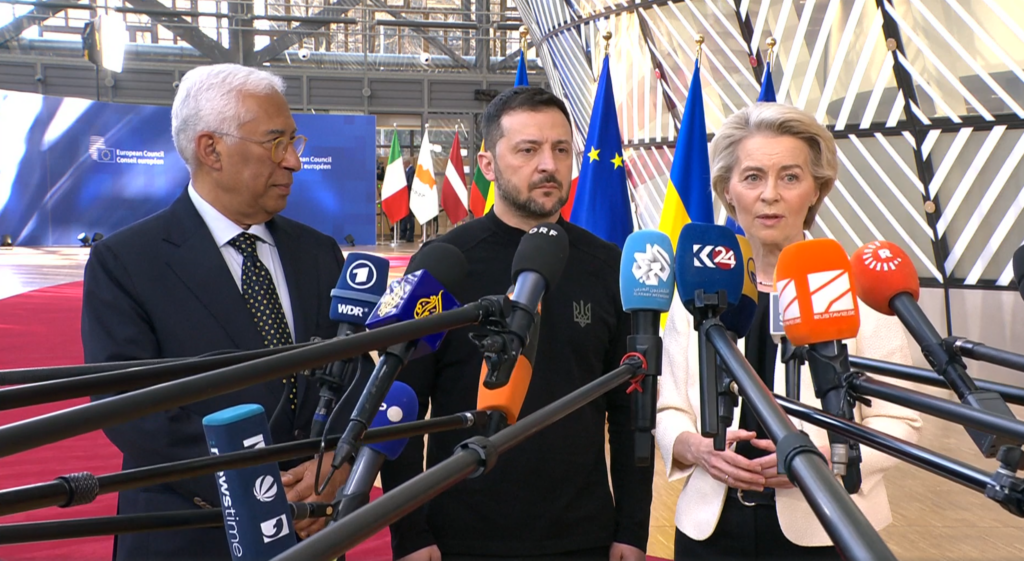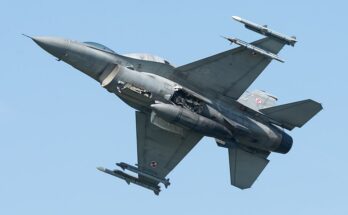
President von der Leyen ahead of the special European Council meeting of 6 March 2025. Image from European Commission video.
After months of tense wrangling, the U.S. and Ukraine formally signed a natural resource development agreement on April 30, establishing plans for a future partnership that will help Ukraine with resource extraction and aid its economic recovery. The announcement followed a direct meeting between Presidents Donald Trump and Volodymyr Zelensky at the Vatican, which evidently went much more smoothly than their dust-up in the Oval Office in February. Completion of the mineral deal eliminates a major point of friction between Presidents Trump and Zelensky, while also putting a spotlight on Washington’s efforts to broker peace between Russia and Ukraine.
While the negotiators initially focused specifically on minerals and rare earths, the final agreement covers all of Ukraine’s subterranean natural resources, including oil and gas. The two sides will create a ‘Reconstruction Investment Fund’ that will drive money towards resource extraction, with both sides controlling equal stakes in the fund. Kyiv retains formal ownership of its resources.
Although it does not include security guarantees for Kyiv, the mineral deal nevertheless keeps Washington engaged on the subject of Ukrainian security. Shortly after the February meeting between the U.S. and Ukrainian leaders collapsed, the U.S. announced a pause in military aid to Ukraine, and terminated other support such as intelligence sharing. These steps were intended to pressure Ukraine on the mineral deal and serve as signal to Moscow that the U.S. was willing to take unilateral steps to wind down its support for Ukraine in exchange for peace.
That stance has shifted. President Trump has made it clear that he is not enthused with U.S. donation of equipment and funds to Ukraine, but he has dropped his demand that Ukraine ‘repay’ the U.S. for the military hardware delivered since 2022. Under the mineral deal announced last week, U.S. aid will continue, though in a change it will now be counted as contribution to the reconstruction investment fund.
U.S. arms sales to Ukraine will also be moving forward. Within hours of the mineral deal’s announcement, reports began circulating in the press that the White House had notified the Congress of an upcoming direct commercial sale worth over $50 million to Ukraine. A DSCA notification followed on Friday, covering the sale of $310.5 million in support services for Ukraine’s European-supplied F-16 fleet. The administration may also ease blocks on third party transfers of U.S. equipment to Ukraine. A New York Times report over the weekend suggested that Israel will transfer decommissioned Patriot air-defenses to Ukraine, a step that can only be taken with Washington’s approval.
The rapid shift in Kyiv’s fortunes following the mineral deal puts a renewed focus on the other major Ukraine-related negotiating track: U.S.-Russia talks. The Trump administration launched intensive dialogue with the Kremlin within weeks of Trump’s inauguration, aiming to end the war in Ukraine and perhaps restore relations between Washington and Moscow. There is little to show for it – the few partial ‘ceasefires’ were immediately violated and Russia has rejected a general cessation of hostilities as only benefiting Ukraine. U.S.-brokered talks now appear to be on the ropes, as frustrated American diplomats have recently warned that the U.S. could walk away from the effort altogether.
There is a litany of reasons why the U.S.-Russia talks have thus far failed to produce a real ceasefire, let alone a serious settlement to the war.
Russian casualties have been immense, but, having reoriented its economy into war mode, Moscow remains capable of sustaining low-level offensive operations, and recruitment of new soldiers continues apace. Unwinding the war engine in the context of a peace agreement, however, would pose significant risks for Russia’s own stability, as Russia would be risking mass desertion of military-trained men from its Armed Forces. Extraordinary defense spending directed towards Russian industry, moreover, has kept the Russian economy afloat, at the cost of reorienting public expenditure away from other priorities. That bill will come due eventually and perhaps sooner if there’s a peace agreement.
Ukraine, for its part, is understandably quite resistant to the idea of formally relinquishing conquered territories to Russia. The Ukrainian government may ultimately be forced into a ‘territory-for-peace’ scheme, but Zelensky has emphasized that no such decision will be made while bullets, missiles, and drones are still being exchanged on the battlefield. While the March cessation of U.S. aid crimped Ukraine’s battlefield capabilities, it did not cripple them, as the country’s own defense industry has stepped up with the provision of artillery weapons and, crucially, one-way attack drones. Kyiv has moreover shored up its relationship with key backers in Europe, who have stepped up their aid to Ukraine even as Washington and Moscow have pointedly excluded them from peace dialogue. Ukraine may not be in the position to make large battlefield advances, but it can certainly prevent Russia from doing so.
Despite the challenges to the peace process, the mineral deal does put pressure on Moscow to negotiate, as it underscores that Washington does not plan to altogether abandon Kyiv, something which the Kremlin has been hoping for while watching the U.S. and Ukraine trade barbs. President Trump spent his initial months heaping blame on President Zelensky for the war; his administration has now shifted the critical eye over to Russia.
“I do believe we’re closer with one party. And maybe not as close with the other, but we’ll have to see,” President Trump said over the weekend in reference to the peace talks. It isn’t hard to figure out which party he was referring to in the latter comment.
Join Forecast International at the Paris Air Show to gain valuable insight into the evolving dynamics of the global defense market. Traditionally regarded as insulated from broader economic fluctuations, the defense sector is now increasingly impacted by global economic forces. Tariffs, trade disputes, and rising economic nationalism are introducing new complexities that affect the stability, cost-efficiency, and resilience of critical defense programs.
For over 50 years, Forecast International has been a trusted authority in aerospace and defense intelligence. Our mission is simple yet vital: to equip industry leaders with the data-driven insight and strategic foresight needed for confident, informed decision-making. Visit us at Hall 3, Booth C164 to learn how our expert analysis can strengthen your planning and elevate your strategy.
Schedule a time to meet with us in Paris.
Military markets analyst, covering Eurasia, Middle East, and Africa.





